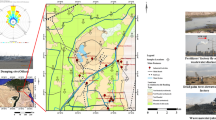Abstract
The shallow sediments in the Smelterville Flats portion of the Coeur d'Alene River Valley in north Idaho consist of a heterogeneous mixture of mine wastes and alluvium reworked during flood events. The wastes cover an area of approximately eight square kilometres. Atomic Absorption Spectroscopy and Inductively-Coupled Plasma analyses on mine waste-sediment samples collected to the depth of the water table show maximum metal concentrations of about 20% Fe, 12% Pb, 10% Zn, 3% Mn, 2.8% Al, 0.13% Cu, 0.1% Cd, 370 ppm As, 170 ppm Ag, 150 ppm Sb, and 70 ppm Ni. The positive correlation between Fe, Ca, and Mg concentrations and sample pH suggests that the carbonate gangue minerals (siderite, ferrodolomite, and ankerite) control the pH. Other metals that exhibit a positive correlation with sample pH also may be present in the carbonate minerals. Identification of factors that govern metal mobility suggests that: (a) the pH of the water in the uppermost aquifer plays a minor role in controlling the solubility of most metals in the solid waste samples; b) the carbonate gangue minerals buffer the ground water pH and hence the solubility of metal sulfides; c) solubility of the carbonate gangue minerals decreases under anaerobic conditions, thereby allowing the ground water pH to decrease; d) solubility of Pb, Zn, and Cd correlates directly to anaerobic conditions as opposed to aerobic conditions.
Similar content being viewed by others
References
Adams, J., 1989, Evaluation of the Hydraulic Interconnection of Two Aquifers Underlying the Smelterville Flats Area, Idaho, M.S. Thesis, University of Idaho, Moscow.
Dames and Moore, 1988, Bunker Hill RI/FS, Preliminary Hydrogeologic Assessment, 15852-003, Document No. 15852PD134/3707, Volume I, pp. 185
Dames and Moore, 1989, Bunker Hill RI/FS, Data Report, Subtask 3.3 Pumping Tests, 15852-003, Document No. 15852-PD094/3303.
Ellis, M.M., 1940, Pollution of the Coeur d'Alene River and Adjacent Waters by Mine Wastes, Special Scientific Report 1, U.S. Bureau of Fisheries.
EPA, 1986, Test Methods for Evaluating Solid Waste, Volume 1 A: Laboratory Manual Physical Chemical Methods, U.S. Government Printing Office, Washington, D.C.
Fryklund, V.C., 1964, Ore Deposits of the Coeur d'Alene District, Shoshone County, Idaho, U.S. Geol. Survey Prof. Paper 445, 103 pp.
Galbraith, J.H., Williams, R.E., Siems, P.L., 1972, Migration and Leaching of Metals from Old Mine Tailings Deposits, Ground Water, Volume 10, No. 3, pp. 33–44.
Hem, J.D., 1970, Study and Interpretation of the Chemical Characteristics of Natural Water, Geological Survey WaterSupply Paper 1473.
Hobbs, S.W., Griggs, A.B., Wallace, R.E., and A.B. Campbell, 1965, Geology of the Coeur d'Alene District, Shoshone County, Idaho, U.S. Geol. Survey Prof. Paper 478, 137 pp.
Ioannou, C., 1979, Distribution, Transport and Reclamation of Abandoned Mine Tailings Along the Coeur d'Alene River and Tributaries, Idaho, M.S. Thesis, University of Idaho, Moscow. 146 pp.
Krauskopf, K.B., 1979, Introduction to Geochemistry (2nd Edition), McGraw-Hill Book Company, 617 pp.
Kunkel, D., 1990, M.S. Thesis, Unviersity of Idaho, Moscow, in progress.
Lindsay, W.L., 1979, Chemical Equilibria in Soils, John Wiley & Sons, pp. 329–341
Marcy, A.D., 1979, The Chemistry of Unconfined Mines Wastes, M.S. Thesis, University of Idaho, Moscow, 198 pp.
Mclean, E.O., 1982, Soil pH and Lime Requirement, Methods of Soil Analysis, Part 2., Chemical and Microbiological Properties Agronomy Monograph No. 9 (2nd Edition), Agronomy Society of America-Soil Science Society of America.
Norton, M.A., 1980, Hydrogeology and Potential Reclamation Procedures for an Uncontrolled Mine Waste Deposition Site, Kellogg, Idaho, M.S., University of Idaho, Moscow, 132 pp.
Reece, D.R., 1974, A Study of the Leaching of Metals from Sediments and Ores and Formation of Acid Mine Water in the Bunker Hill Mine, M.S. Thesis, University of Idaho, Moscow.
Ralston, D.R., Trexler, B.D., and Wai, C.M., 1973, Solutions to Problems of Pollution Associated with Mining in Northern Idaho, U.S. Bureau of Mines Contract Report H0122070.
Towatana, P., 1990, Geochemistry of Waste-sediment Mixtures in the Smelterville Flats Area of the Coeur d'Alene Mining District, Kellogg, Idaho, Ph.D. Thesis, University of Idaho, Moscow, 193 pp.
Williams, R.E., Ortman, D., Mabes, D. Reece, Norman, L., and Eier, D., 1979, Leakage and Seepage From Tailings Ponds: The Bunker Hill Central Impoundment Area, Kellogg, Idaho, U.S. Bureau of Mines Contract No. G0155210, College of Mines, University of Idaho, Moscow.
Author information
Authors and Affiliations
Rights and permissions
About this article
Cite this article
Chamberlain, V.E., Williams, R.E. & Towatana, P. Metal concentrations and concomitant metal mobility in unsaturated mine and mill wastes. Mine Water and the Environment 14, 23–37 (1995). https://doi.org/10.1007/BF02914851
Issue Date:
DOI: https://doi.org/10.1007/BF02914851




